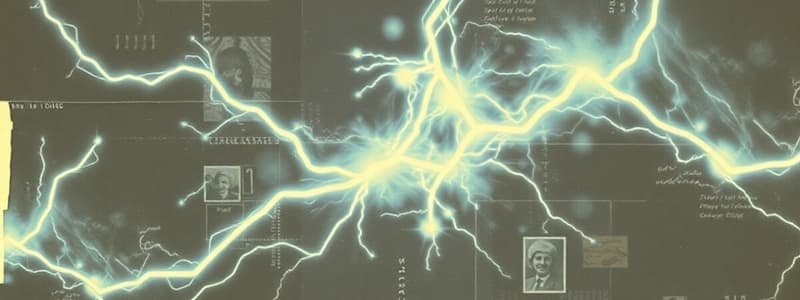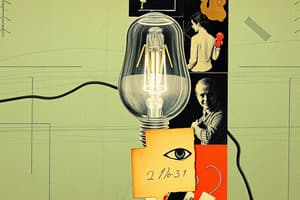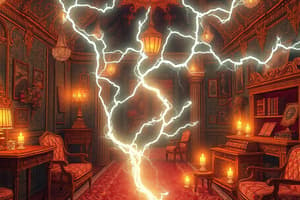Podcast
Questions and Answers
Which of the following best describes the role of valence electrons in electric current within metals?
Which of the following best describes the role of valence electrons in electric current within metals?
- They are free to move within the conductor and constitute an electric current. (correct)
- They create resistance to the flow of electric current.
- They insulate the conductor to prevent current leakage.
- They are tightly bound to the nucleus and do not contribute to current.
How does the 'electron sea model' describe electric current in a solid conductor?
How does the 'electron sea model' describe electric current in a solid conductor?
- Free electrons drift through the conductor, jumping randomly between positive ions. (correct)
- Electrons remain bound to their atoms and only vibrate in place.
- Electrons are passed directly from one atom to the next in a chain.
- Electrons flow in a fixed lattice structure within the conductor.
What is the fundamental difference between conductors and insulators based on their atomic structure?
What is the fundamental difference between conductors and insulators based on their atomic structure?
- Conductors have more protons than insulators.
- Insulators are made of heavier atoms than conductors.
- Conductors offer less opposition to current flow due to free electrons, unlike insulators. (correct)
- Insulators have freely moving electrons, while conductors do not.
Under what circumstance is the 'terminal voltage' of a cell equal to its EMF?
Under what circumstance is the 'terminal voltage' of a cell equal to its EMF?
How is electric potential at a point typically defined?
How is electric potential at a point typically defined?
According to Ohm's Law, what relationship exists between the current flowing through an ohmic conductor and the potential difference across it?
According to Ohm's Law, what relationship exists between the current flowing through an ohmic conductor and the potential difference across it?
How does increasing the length of a conductor typically affect its electrical resistance?
How does increasing the length of a conductor typically affect its electrical resistance?
What distinguishes 'Ohmic' resistors from 'Non-Ohmic' resistors?
What distinguishes 'Ohmic' resistors from 'Non-Ohmic' resistors?
According to Joule's Law, how does the heat generated in a conductor relate to the current flowing through it?
According to Joule's Law, how does the heat generated in a conductor relate to the current flowing through it?
How is one kilowatt-hour (kWh) defined in the context of electrical energy consumption?
How is one kilowatt-hour (kWh) defined in the context of electrical energy consumption?
Flashcards
What is Charge?
What is Charge?
An intrinsic property of matter that causes it to experience a force when placed in an electromagnetic field.
What are Conductors?
What are Conductors?
Substances offering less opposition to current flow.
What is Electric Potential?
What is Electric Potential?
Work done to bring a unit positive charge from infinity to a point. Potential difference is between two points.
What is Electric Current?
What is Electric Current?
Signup and view all the flashcards
What is Drift Velocity?
What is Drift Velocity?
Signup and view all the flashcards
What is an Electric Circuit?
What is an Electric Circuit?
Signup and view all the flashcards
What is Resistance?
What is Resistance?
Signup and view all the flashcards
What is Resistivity?
What is Resistivity?
Signup and view all the flashcards
What are Ohmic Resistors?
What are Ohmic Resistors?
Signup and view all the flashcards
What are Superconductors?
What are Superconductors?
Signup and view all the flashcards
Study Notes
- Electricity involves current and voltage and the study of electric charges and their movement.
Atomic Structure
- Atoms contain a positively charged nucleus with negatively charged electrons that revolve around it
- Valence electrons in metals are free to move within conductors, forming electric current
Charge
- Charge is an intrinsic property of matter that allows it to exert electromagnetic force
- Like charges repel each other, while opposite charges attract
Conductors and Insulators
- Conductors offer less opposition to current flow, while insulators offer more
Electric Potential and Potential Difference
- Electric potential at a point is the work needed to bring a unit positive charge from infinity to that point
- Potential difference between two points is the difference in electric potentials between those points.
Electric Current
- Electric current (I) refers to the flow of electric charges, defined as charge per unit time: I = Q/t
Electron Sea Model
- Electric current in solid conductors results from the drift of free electrons able to jump to neighboring atoms.
- The model includes positive metal ions and an "electron cloud" that does not belong to any metal ion
Drift Velocity of Electrons
- Drift velocity is the average velocity an electron attains inside a metallic conductor when influenced by an electric field due to a potential difference
Battery
- A cell serves as a source of potential difference, generated internally through chemical reactions
- At the anode: Cu(s) → Cu2+(aq) + 2e-
- At the cathode: Ag(aq) + 2e- → 2Ag(s)
- A battery is a combination of multiple cells
Electric Circuit
- An electric circuit is a closed-loop path that allows current to flow
- A circuit diagram represents an electric circuit using symbols
- An ammeter measures current, a voltmeter measures voltage, and resistance opposes current flow.
Resistance and Ohm's Law
- Ohm's Law: The current through an ohmic conductor is directly proportional to the applied potential difference across its ends
Resistance
- Resistance measures the opposition to current flow in an electric circuit
Factors Affecting Resistance
- Length: Resistance is directly proportional to the conductor's length
- Nature: Resistance is directly proportional to the material's nature
- Temperature: Resistance is directly proportional to the conductor's temperature
- Cross-sectional area: Resistance is inversely proportional to the conductor's cross-sectional area
Resistivity
- Resistivity is the electrical resistance of a substance with unit length and unit cross-sectional area
Ohmic and Non-Ohmic Resistors
- Ohmic resistors follow Ohm's Law, whereas non-Ohmic resistors do not.
Superconductors
- Superconductors are conductors that offer zero resistance to the flow of current
Combination of Resistors
- Resistors in series carry the same current
- Resistors in parallel have the same potential difference applied to them
Equivalent Resistance
- For series circuits, Req = R1 + R2
- For parallel circuits, 1/Req = 1/R1 + 1/R2
EMF and Terminal Voltage
- EMF is the potential difference between terminals of a cell when no current flows
- Terminal voltage refers to the potential difference when current is flowing
Heating Effect of Current
- Joule's Law describes heating effect of current
- Heat (H) ∝ square of the current (I)
- H ∝ Resistance of the circuit
- H ∝ Time (t) for which current flows
Electric Power
- Electric power is the rate of doing work or energy consumption, P = W/t
- The S.I. unit for power is the Watt (W).
- 1 Watt is consumed when 1 A of current flows at a potential difference of 1 V
- Commercial unit of electrical energy is kilowatt-hour (kWh) = 3.6 × 10^6 J
- 1 kilowatt-hour is used by 1kW of power for 1 hour
- Power represented as P = I²R and P = V²/R
Studying That Suits You
Use AI to generate personalized quizzes and flashcards to suit your learning preferences.




